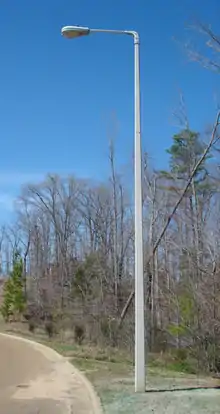Street light interference phenomenon
Street light interference (SLI) is a term coined by paranormal author Hilary Evans to denote the claimed ability of individuals to turn street lights or outside building security lights on or off when passing near them. Believers in SLI allege that they experience it on a regular basis with specific lamps and street lights and more frequently than chance would explain; however, SLI has never been demonstrated to occur in a scientific experiment, and those who claim the ability have been found to be unable to reproduce the effect on demand.[1][2][3]


Proponents
According to Evans, SLI is a phenomenon "based on claims by many people that they involuntarily, and usually spontaneously, cause street lamps to go out." Evans' 1993 book The SLI Effect proposes that the phenomenon is "not consistent with our current knowledge of how people interact with the physical world." Evans coined the term "SLIder" to refer to someone who allegedly causes this effect, and cites SLIders' claims of being able to "extinguish a row of sodium vapor lamps in sequence, each one going out as the witnesses nears it."[2]
Some proponents believe static electricity or "some kind of “energy” emitted by the human body" is responsible for SLI. Others claim the alleged phenomenon is caused by individuals having psychic or psychokinetic ability.[1]
Reception
Author Massimo Polidoro writing in Skeptical Inquirer has considered claims of SLI to be examples of correlation not implying causation, or of confirmation bias: people are much more likely to notice when a nearby street light turns on or off than they are to notice a light turning on or off at a distance, or a street light in a steady state at any distance. This is compounded by a failure mode of street lights, known as "cycling", in which street lights of the high pressure sodium type turn off and on more frequently at the end of their life cycle.[4] A high pressure sodium engineer at General Electric, quoted by Cecil Adams, summarizes SLI as "a combination of coincidence and wishful thinking".[4] Polidoro notes that "Paranormal phenomenon is the least likely possibility."[2]
See also
- Association for the Scientific Study of Anomalous Phenomena
- Deluminator, a fictional Harry Potter device.
- Gas-discharge lamp
- High-intensity discharge lamp
- Mercury-vapor lamp
- Sodium vapor lamp
References
- Linton Weeks. "Bad Karma, Or Just Bad Lightbulbs?; The Mystery Of Blinking Street Lights." The Washington Post. Washingtonpost Newsweek Interactive. 2002. HighBeam Research Archived 2002-03-31 at the Wayback Machine. 19 September 2014
- Polidoro, Massimo (November 2008). "The Curious Case of Street Lamp Interference". The Skeptical Inquirer. Amherst, New York: Committee for Skeptical Inquiry. 32 (6): 21–22. Retrieved 19 November 2017.
- Independent Investigations Group. "Light Bulb Luminosity Demonstration". Committee for Skeptical Inquiry. Center For Inquiry. Retrieved 14 June 2018.
- Cecil" Adams. "Can some people extinguish streetlamps by means of their bodily emanations?" In "The Straight Dope", October 28, 1994. Retrieved April 6, 2007.
Further reading
- "Street Light Interference" by Dennis Stacy, Omni (1990)
- "Street Light Interference" by Robert McMorris, Omaha World-Herald (1990}
- "Electric Discharge Lamps" by John Waymouth MIT Press (1971)
External links
- The SLI Effect by Hilary Evans - free download book on Street Light Interference. ISBN 0-9521311-0-2
- "Close Encounters of the Street Lamp Kind", David Morrow, The Independent, August 30, 1995